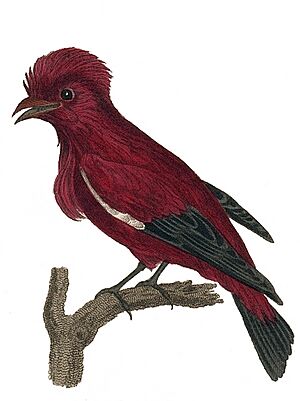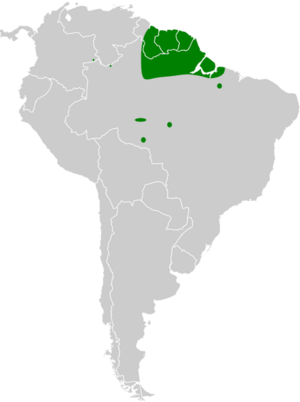Crimson fruitcrow facts for kids
Quick facts for kids Crimson fruitcrow |
|
|---|---|
 |
|
| Conservation status | |
| Scientific classification | |
| Genus: |
Haematoderus
|
| Species: |
militaris
|
 |
|
The crimson fruitcrow is a really cool bird with bright red feathers! Even though its name has "crow" in it, it's actually part of a different bird family called Cotingidae. It's the only bird in its special group, or genus, called Haematoderus. You can find this amazing bird in countries like Brazil, French Guiana, Guyana, Suriname, and Venezuela. It loves living in warm, wet forests in low-lying areas. This bird has a wide range and lots of them live there, so it's not considered in danger of disappearing.
Contents
Meet the Crimson Fruitcrow
The crimson fruitcrow is a large bird, about 34 centimeters (13 inches) long. Imagine a bird about the size of a ruler!
What Does it Look Like?
- Adult males: These birds are super flashy! They have shiny, bright red feathers on their head, back, and chest. These feathers are long and stiff. They can even raise a bushy red crest on their head! Their wings and tail are dark brown or black.
- Females and young males: They are a bit less bright. Their head, throat, and belly are a lighter red. Their back, wings, and tail are dark brown, and their feathers are softer.
Both male and female crimson fruitcrows have thick, dark red beaks.
Where Do Crimson Fruitcrows Live?
This special bird lives in the tropical, wet rainforests of Guyana, French Guiana, and northeastern Brazil. Sometimes, people have seen them outside their usual homes, like in western Brazil and eastern Venezuela. It's not a super common bird, but you can spot it high up in the forest trees, especially at the edges of the woods.
Crimson Fruitcrow Behavior
Even though it's called a "fruitcrow," this bird mostly eats large insects! It loves munching on cicadas, beetles, and grasshoppers. Sometimes, it adds fruit to its diet.
How Do They Fly?
The crimson fruitcrow has a relaxed, looping way of flying. They've even been seen doing a special display flight! This involves flying upwards in a spiral shape, then gliding down for a long time.
Where Do They Hang Out?
These birds like to perch high up in the canopy (the top layer of the forest trees). It seems each bird has its favorite spot to sit and watch.
What Sounds Do They Make?
Usually, the crimson fruitcrow is pretty quiet. But sometimes, it makes a low hooting sound, a bit like an owl. It also has a sharp "bok" call.
Is the Crimson Fruitcrow Safe?
The crimson fruitcrow isn't very common, and its numbers might be slowly going down in some places. However, it lives across a very large area. Because of its wide range, the International Union for Conservation of Nature (a group that checks on animals) says it's a "least concern" species. This means they don't think it's in danger of disappearing right now.


